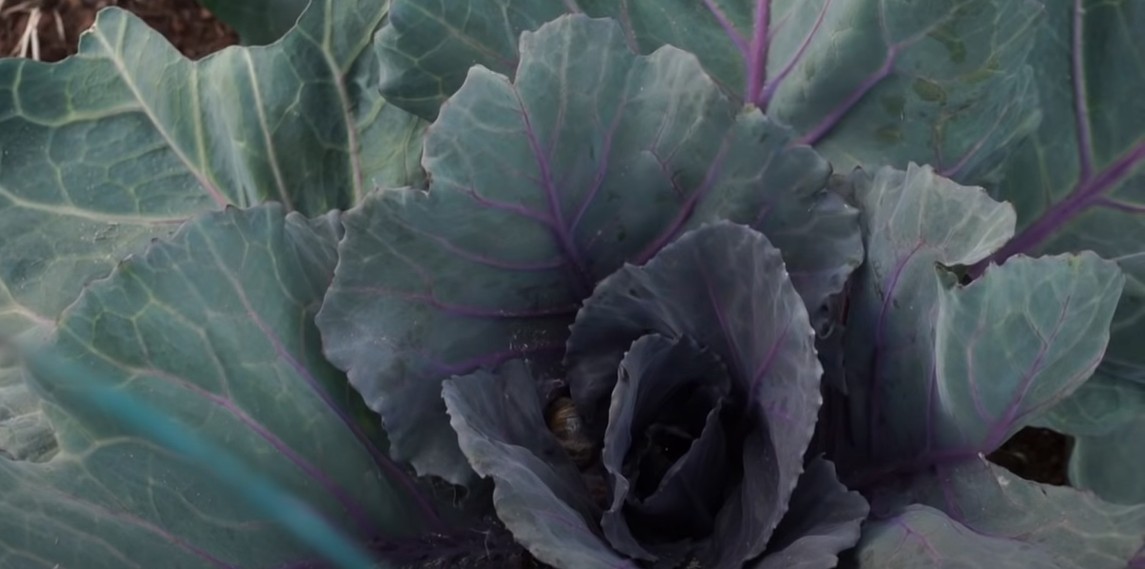Purple cabbage is a type of cabbage vegetable with purple-colored leaves and head. Apart from its purple pigmentation, the cabbage has some particulars similar to regular green cabbage. The actual color of purple cabbage is influenced by the pH of the soil in which it is raised. For this reason, it is sometimes referred to as red cabbage, as it can also look redder than it is purple. Red cabbage is a versatile vegetable that is used in a variety of culinary applications in its raw form or cooked.
Table of Contents
What is Purple Cabbage?
Purple cabbage is a legitimate member of the species Brassica oleracea var. capitata which it shares with regular green cabbage that many people are more familiar with. However, the precise scientific name of red cabbage within this species is Brassica oleracea var. capitata f. rubra.
Cabbages belong to the Brassicaceae or Cruciferae family, which is also known as the cabbage family. Other common vegetables in this family include broccoli, cauliflower, kale, and collards.
Purple or red cabbage are also known by other names such as blue kraut or red kraut respectively. One notable aspect about purple-colored cabbage is that the color of the cabbage, as earlier mentioned, is influenced by the pH of the soil in which the cabbage is growing. For example, when raised in acidic soil, the cabbage leaves turn out reddish and when raised in neutral soils they turn purple.
This behavior is not only restricted to purple cabbages. It also occurs in a variety of other fruits and vegetables that contain naturally occurring anthocyanins just like purple cabbage. Anthocyanins are water-soluble pigments that give fruits and vegetables their red, purple, or black color.
According to the journal Food and Nutrition Research, the “color and stability of these pigments are influenced by pH, light, temperature, and structure. In acidic conditions, anthocyanins appear as red but turn blue when the pH increases”. As shall be discussed in the next section, purple cabbage anthocyanins carry important human health benefits that must not be ignored.
Nevertheless, there are other notable characteristics about purple-colored cabbage such as its hard-headed center. The head is very compact and tightly packed; it is very hard to squeeze using a bare hand.
Furthermore, whilst in the ground, the cabbage has huge opened largely ovate or egg-shaped greenish leaves with apparent shades of purple or red color. This is perhaps the most notable hallmark of purple cabbage.
Unless the outer leaves of the head are removed to reveal the compact purple head, the extent of the purple color is not initially apparent nor appreciated.
Purple Cabbage Nutrition and Benefits
Purple or red cabbages are very nutritious vegetables and among the most important and easily available dietary vegetables. There are at least 5 notable nutrients to be derived from purple cabbage some of which remain accessible even after the cabbage has been cooked. Some of the major nutrients found in purple-colored cabbage are Vitamins K, C, and B6, Manganese, and Iron.
According to Harvard Health, half a cup of cabbage has only 14 calories but provides as much as 45% of the daily recommended amount of vitamin C. All body tissues are dependent on vitamin C for their repair and development, for example. Also to be considered is that the low-calorie value of cabbage makes the vegetable ideal in weight loss diets.
Nevertheless, apart from the nutritional value of purple cabbage, there are other superior health benefits that have now been scientifically proven to be associated with anthocyanins in purple-colored cabbage.
Flowing out of this understanding, purple or red cabbage is considered a functional food. Functional foods present higher-ranking health benefits that go beyond just nutrition.
According to a 2004 scientific report that appeared in the Journal of Biomedicine and Biotechnology, anthocyanins in purple cabbage and other fruits and vegetables are more than just colors.
Apparently, anthocyanins are antioxidants that carry demonstrable benefits in humans such as prevention of liver injury, blood pressure reduction, eyesight enhancement, cancer prevention, and anti-inflammatory effects.
Going by these validated scientific claims, there is thus more benefit, health-wise, in eating purple cabbage compared to regular green cabbage. In addition, purple-colored cabbage becomes one important source of health-beneficial anthocyanins alongside blackberries, blueberries, purple eggplants, plums, and prunes, for example.
Purple Cabbage vs Green Cabbage
One of the most common comparisons often done is between purple and green cabbage. To begin with, purple and green cabbages are two distinct cabbage cultivars as much as they are of the same species and family.
Culinary speaking, both cabbage types have just about the same recipe applications. Both can be used raw or cooked, alone or together, especially in salads for color. Purple cabbage just like green cabbage has a peppery flavor when raw and a sweeter taste when cooked.
However, to be noted is that whereas green cabbage remains intact when cooked, purple or red cabbage has a tendency to leak the color, so to speak. This is because anthocyanins in the cabbage are water-soluble.
To prevent the purple color from running out of the cabbage when cooking, a common trick is to add a small dose of an acid such as vinegar or lemon juice to the cooking water.
Yet another difference between purple cabbage and green cabbage is in the physiological makeup of blue kraut. As earlier mentioned, blue kraut has a smaller tight head, very compact and solid. On the other hand, green cabbages generally have loose heads which are not as hard as their purple cousins.
Depending on intended use, this may or may not be of any meaningful consequence. For example, tightly packed cabbage heads may be easier to slice with better presentable results.
Another key comparison to be made is on the health benefits of red cabbage vs green cabbage. This flows from the fact that red cabbages are rich in anthocyanins while green cabbages contain chlorophyll.
As earlier mentioned, purple-colored cabbage contains superior health benefits over regular green cabbage such as prevention of liver injury, blood pressure reduction, and eyesight enhancement among others. Overall, a diet rich in purple cabbage has better long-term health benefits compared to a diet that is only limited to green cabbage.
In summary, juxtaposed, purple cabbage vs green cabbage equally reveals some marked similarities as well as differences between the two. However, differences such as better health benefits for purple cabbage are apparently consequential.
Purple Cabbage vs Red Cabbage
Purple and red cabbage are names used interchangeably to essentially refer to the same cabbage type. For all intents and purposes, the difference is in name only. However, scientifically, there may be some differences between purple cabbage and red cabbage at pigmentation intensity level.
As earlier discussed, whether a red cabbage head ends up looking red or purple is a matter of certain environmental factors. Red cabbages that are raised in acidic conditions, that is to say in soil with a pH of below 7.0, will appear red.
On the other hand, purple cabbages raised in high pH, or alkaline conditions, will appear purple. According to scientific studies, soil pH, and temperature plays an important role in influencing the intensity of the red in red cabbages. This also applies to a variety of other fruits and vegetables which have anthocyanins.
For the avoidance of doubt, green cabbages will not have this same outcome even when the same conditions are applied because the cultivar does not have anthocyanins in the first place.
Purple Cabbage vs Lettuce
Purple cabbage and lettuce are often compared on various grounds including substitution and health benefits. To set the stage, purple or red cabbage is a completely different vegetable species from lettuce. The scientific name of lettuce is Lactuca sativa while that of cabbage is Brassica oleracea var. capitata. In addition, the two are not even in the same family.
Also to keep in mind when doing a comparison between the two is that there are also various types of lettuces. Some like Frisée, are not true lettuce while other lettuces are loose-leaf lettuces that do not form heads.
Furthermore, there is also green lettuce as well as red or purple lettuce. All these aspects impact the use and health benefits associated with lettuce in comparison to purple cabbage.
In respect of health benefits, purple or red cabbage has more to offer compared to green lettuce, for example. However, when compared with purple lettuce, both vegetables have functional health benefits that they bring to the table. Both vegetables contain the earlier discussed health-enriching anthocyanins. Taking this into consideration, there is a compelling reason, where applicable, to substitute purple cabbage with purple lettuce compared to green lettuce.
Regarding nutritional value, given a 300-gram serving of both for comparison purposes, lettuce emerges with more vitamins to offer than purple cabbage or cabbage in general. Compared to cabbage, lettuce has more vitamins A, E, B1, B2, B3, and K.
According to one source, lettuce has nearly 7500% more vitamin A compared to cabbage. On the other hand, cabbage has more vitamin C, B5, B6, folate, and fiber compared to lettuce. As part of a weight loss diet, lettuce would do better than cabbage due to its lower calories per serving.
Furthermore, concerning substitution, there are much fewer opportunities to use lettuce as a replacement for purple cabbage. A possible opportunity would be replacing purple or red cabbage with purple lettuce in a salad.
Overall, cabbage is much more versatile compared to lettuce if one takes into account that it can also be cooked, which is generally not the norm with lettuce which is often used raw.
Purple Cabbage vs Spinach
Juxtaposed, purple cabbage and spinach are two different vegetable species. Spinach belongs to the species Spinacia oleracea and amaranth family along with beets, and quinoa. There is thus no relationship between the two at the species level.
Nonetheless, both vegetables have some highly valuable offerings pertaining to human health benefits. They are both functional foods that offer more than just nutritional value.
For example, Spinach leaves are not only used for culinary purposes but are also used as medicine associated with the treatment of stomach and intestinal or gastrointestinal problems.
On the other hand, as already been discussed, purple cabbage contains antioxidants that are associated with the prevention of a variety of ailments. These are all important functional benefits to human health offered by both vegetables.
Regarding nutritional comparison, Spinach has at least two times more calcium than purple-colored cabbage per 100 grams of serving. Furthermore, in the same amount of serving, Spinach has multiple times more vitamins A, E, and K than purple-colored cabbage so is fructose and iron.
On the other hand, purple cabbage brings to the table more dietary fiber than Spinach by a factor of 13. In addition, purple cabbage has 30 times more vitamin C per 100g serving than Spinach.
In respect of recipe applications, purple-colored cabbage has very different uses contrasted with Spinach. However, in some cases, the two can be used in the same dish, an example being salads.
However, what is clear from this comparison is that both vegetables have their own strengths which cannot be matched by the other. Therefore, for maximum benefits from both worlds, it is ideal to have both vegetables as part of the regular diet.
Purple Cabbage vs White Cabbage
On account of its origin, white cabbage is also known as Dutch cabbage. In comparing purple vs white cabbage, we first keep in mind that white cabbage is in fact a type of green cabbage. White cabbage is however distinguishable from regular green cabbage in that white cabbage has pale-colored outer leaves and a white head.
In addition, white cabbage can simply be green cabbage that has turned pale or white due to chlorophyll breakdown during storage. While purple cabbage is red or purple in color, especially the head, white cabbage is white due to cultivar or changes that occur in storage.
Side-by-side for nutrition and health benefits, purple cabbage brings more to the table than white cabbage. Earlier discussed anthocyanins as found in purple or red cabbage represent the key differentiator between the two cabbage types from a health benefits angle.
As already stated, anthocyanins, which are not found in white cabbage, carry a host of functional health benefits beyond just nutrition such as anti-inflammation, anti-cancer, and blood pressure lowering.
On the other hand, white cabbage is richer in fiber. Vitamins and minerals such as vitamin C, B6, and K, folate, and thiamin are also found in purple cabbage.
Furthermore, compared to purple cabbage, some white cabbage varieties such as Expect, Zacapa, Axel by Bejo Seeds have better long-term storage than their purple cousins. In respect of culinary uses, the two cabbage types can be used interchangeably or together. There is no significant taste or flavor difference between purple and white cabbage. These are essentially the same species and of the same cabbage family.
Purple Cabbage Recipes
The primary use of purple cabbage is for culinary purposes in salads, juicing, and other cooking applications. There are, however, other secondary uses such as in extracts and even as a simple pH indicator as shown in this experiment.
Nevertheless, how purple cabbage is cooked matters. According to a 2014 study published in the journal Food Chemistry, certain domestic methods used in cooking purple or red cabbage are detrimental to their nutritional value.
Compared to using the vegetable fresh, all cooking methods were found to cause a significant reduction in health-enriching anthocyanins and total glucosinolates contents. Although cooking remains permissible, this study highlighted the importance of consuming the cabbage raw as much as possible.
Even so, the following is our collection of some scrumptious recipes to try out using purple or red cabbage.
Purple Cabbage Juice Recipe
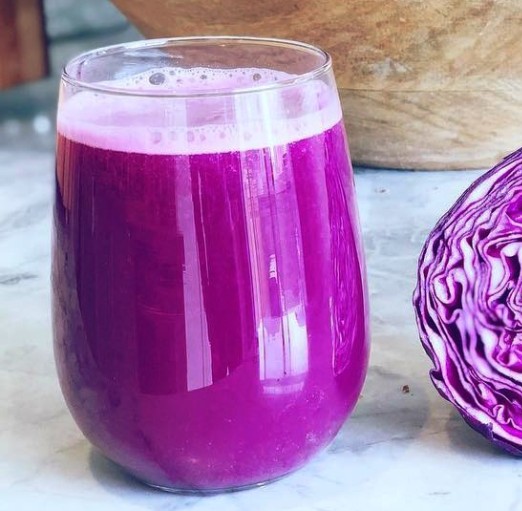
This recipe essentially presents a simple method of producing homemade purple juice extract from cabbage. What you get in the end is an antioxidant-rich juice. Ingredients will be purple cabbage, tomatoes, and honey. This recipe involves no cooking so the juice extract you get is in its best state with no heat introduced.
The most important equipment in the recipe will be a good juicer (example) that does the job well. The recipe takes 10 minutes to make and yields 4. View Recipe.
Cabbage and Cucumber Salad Recipe
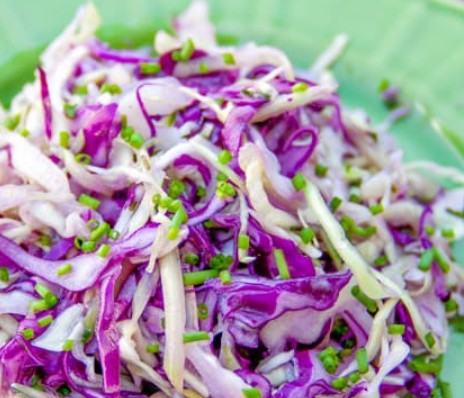
This is yet another no-cooking dish that produces a colorful salad that utilizes both purple and white cabbages. Another dimension to the salad is the cucumber. You will need bitterless cucumbers such as English cucumber, Persian cucumber or even lemon cucumber.
Sunflower oil brings a nice flavor to the salad. Vinegar and green onion will be the other ingredients going into the recipe. The vegetables will look very nice when sliced using a mandoline (example) which will all lead to an inviting salad dish. The recipe takes 10 minutes to make and can be made for under $5. View Recipe.
Vegan Purple Antioxidant Juice Recipe
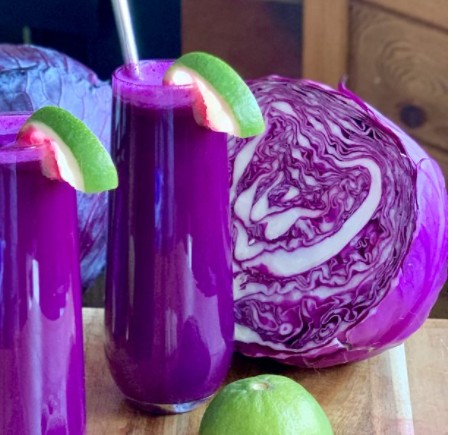
This recipe is a vegan-friendly detoxing purple juice extract. There are three main ingredients to the recipe, purple cabbage, ginger, and lime. The lime will also serve the purpose of garnishing the glasses that serve the juice. As before, this recipe will need a very good juicer (example) for best results.
Chunks of the cabbage are fed into the juicer. You will need a good juicer to properly extract the juice from the cabbage. The final product will be served chilled. The recipe takes 5 minutes to make and will yield 4. Each serving will have about 69 calories. View Recipe.
Cabbage Roasted Sweet Potato Salad Recipe

This recipe brings an interesting angle to purple or red cabbage by combining it with sweet potato. The dish preparation is in two parts, the salad itself, and the ingredients. The cabbage will be added uncooked. Only sweet potato and rice are cooked.
Some ingredient highlights include pomegranates (for the seeds), almonds, coriander, cumin, salt and pepper, lemon, and olive oil. The final dish can be kept in the fridge for two days before it significantly changes in flavor. This recipe is ready in 50 minutes and serves 8. View Recipe.
Growing Purple Cabbage
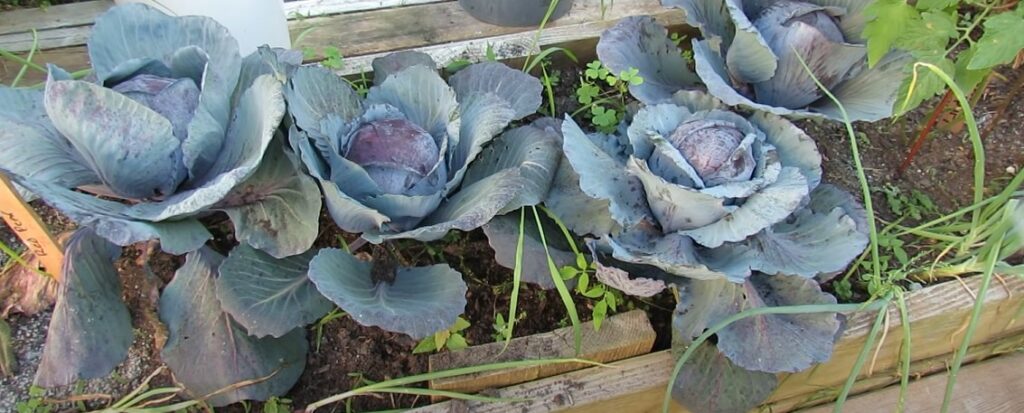
The growing culture for purple cabbage is similar in many respects to growing cabbages in general. This is to say key requirements when growing regular green cabbage also apply when growing this type of cabbage. Below are some considerations when raising purple cabbage in a home gardening setting. The cabbage can be grown directly in the ground, raised beds, and even containers.
Growing Soil
Aim to grow the cabbage in organic matter that is mixed with mature compost. It is common practice for some growers to add blood meal fertilizer to the soil as a nitrogen amendment. This is ideal for cabbages because no fruit is expected but a lush crop made up of healthy leaves.
Blood meal (example), will raise nitrogen in the soil resulting in a lush purple cabbage crop. Furthermore, the soil in which the cabbage is planted must be well-draining soil to prevent waterlogging. If the garden is poorly drained, the cabbage crop becomes highly vulnerable to black rot, peppery leaf spot, and Fusarium diseases.
Spacing
Cabbage should be put in the ground from about mid-spring onwards. Prior to this time, it can be started indoors. The best spacing of the cabbage transplants should be between 18 inches to 24 inches or 47 cm to 61 cm.
In addition, the cabbage transplants should be planted 4 inches or 10 cm deep. This depth is useful as a way of protecting the young cabbage plants from an early attack from pill bug pests that eat the stems. Pill bugs target new transplants of a variety of crops from cabbages to peppers.
Watering
Like all cabbages, purple cabbage requires a good and consistent watering routine. Keep the soil moist at all times avoiding periods of drought. To reduce the risk of dry soil, use mulching to retain as much moisture as possible in the soil.
Sun
Although cabbage can do well in partial shade, full sun exposure is recommended, at least 6 hours per day. Cabbage has huge leaves which require a good amount of sun to generate food for the growing head. The more sun it can get, the better.
Harvest
The cabbage will be ready for harvest 70 to 85 days after setting the transplants in the soil. To tell if the cabbage is ready for harvest at this time, squeeze the head. The head should be hard and tightly packed. As earlier stated, purple cabbages tend to have harder heads than regular green cabbage.
As much as growing purple-colored cabbage is easy and straightforward, there is certainly more to appreciate about it and growing cabbage in general. We recommend this resource, Growing Cabbage in Home Gardens, by the University of Minnesota Extension.
Conclusion
Purple cabbage is sometimes referred to as red cabbage. It is distinctly different from green cabbage on the basis of pigmentation. Due to its purple pigmentation, purple or red cabbage has unique health benefits that can not be equally obtained from regular green cabbage as much as both cabbage types are nutritious.
Whether a cabbage looks red or purple is a matter of growing conditions such as soil pH and temperature. Purple-colored cabbages are applicable in a variety of culinary applications although they do not offer any significantly different flavor. Growing purple-colored cabbage is fairy easy and follows similar methods as those used when raising green or white cabbage.
Random But Good Reads:-
- Purple Lettuce Information
- Frisée Lettuce Information
- Cinnamon Basil Information
- Purple Broccoli Information
- Pimento Peppers Information
- Buttercrunch Lettuce Information
- Boston Lettuce Information
- Black Cherry Tomato Information
- Cipollini Onions Information
- Murasaki Sweet Potatoes
- Pasta Recipes with Shrimp
- Perfect Hard Boiled Eggs
